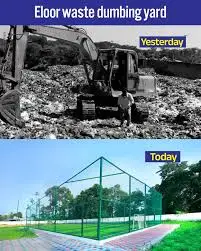How Kerala’s Eloor municipality turned landfill site into football field

A Landmark Transformation in Eloor
Eloor, a small yet industrious municipality near Kochi in Kerala, has made headlines for all the right reasons. Once plagued by pollution and health hazards from an unmanaged landfill, the town has now turned that same site into a thriving green space—a football ground that echoes with the laughter of children and the cheers of young players.
This transformation is not just about building a sports facility; it’s a testament to what determined governance and environmental awareness can achieve when combined with community support.
The Story of Kuzhikandam: From Dumping Yard to Community Hub
For years, Kuzhikandam served as the primary dumping yard for Eloor. Residents nearby suffered from the stench, groundwater contamination, and frequent health complaints due to the unscientific waste disposal practices.
But the turning point came in 2015 when the municipality officially shut down the landfill. With mounting pressure from residents and a growing need for sustainable solutions, local leaders committed to a new vision: to reclaim the land and return it to the people in the form of a useful public space.
Ambedkar Gramam Project: Reviving a Community
This ambitious redevelopment was carried out under the Ambedkar Gramam project, spearheaded by Minister P. Rajeev, who also represents the Kalamassery constituency.
Backed by a budget of ₹60 lakh, the former waste yard was completely cleaned, leveled, and reimagined as a multi-use community space. The newly developed facility features:
- A professional turf football field
- A children’s park equipped with modern play structures
- Pathways and benches for morning walkers and visitors
- LED lighting for evening use
Open to the public daily during morning and evening hours, the ground has quickly become a favorite spot for families, sports enthusiasts, and local clubs.
Model for Waste Management and Urban Reuse
Eloor’s success didn’t stop at Kuzhikandam. The municipality has also taken steps to establish decentralized waste processing systems, such as aerobic composting and the Thumboormuzhi model for organic waste. They’ve transformed other minor dumping spots into flower gardens, promoting cleanliness and aesthetics hand-in-hand.
By doing so, Eloor has become a shining example for other urban areas struggling with legacy waste problems. The emphasis is now on recycling, reusing, and restoring—not just in words but in visible, community-driven action.
Community Involvement and Awareness
One of the key drivers of this transformation has been the involvement of the local community. Awareness campaigns, school programs, and resident association meetings have ensured that people not only understand the importance of proper waste management but also actively participate in maintaining these new public spaces.
Children who once grew up near a stinking landfill are now playing on green turf. Senior citizens walk in peace where garbage once piled. This turnaround represents a holistic urban renewal—physical, environmental, and emotional.
Conclusion: A Vision for the Future
Eloor’s transformation is not merely a case of infrastructure development—it’s a model of responsible urban planning and people-centric governance. By turning a once-polluted dumping yard into a symbol of hope and recreation, the municipality has sent out a clear message: no space is beyond redemption if the intent is honest and the action is collective.
As cities across India grapple with the twin challenges of waste and shrinking public spaces, Eloor’s story stands tall as an inspiration—proving that with the right vision, even a landfill can become a field of dreams.






